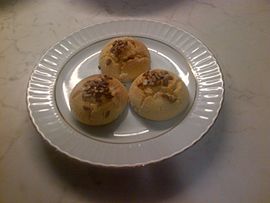Flour kurabiye
This article has multiple issues. Please help improve it or discuss these issues on the talk page. (Learn how and when to remove these messages)
|
 | |
| Alternative names | Flour kurabiye |
|---|---|
| Type | Kurabiye |
| Place of origin | Turkey |
| Main ingredients | Butter, sunflower oil, sugar icing, corn starch, vanilla powder, flour |
Flour kurabiye (Turkish: Un kurabiyesi) is a kind of Turkish cookie that is made from butter, sunflower oil (or another mild flavored oil), baking powder, and the namesake ingredient flour. Generally, vanilla powder (commonly used as a substitute for vanilla extract in Turkish baked goods) is also added. Flour kurabiye is a variant of kurabiye.
Also known as Turkish Shortbread, these simple, melt-in-your-mouth cookies are traditionally served with Turkish tea. They are rolled into logs, sliced, and baked until just barely set.[1]
Origin
[edit]The word "kurabiye" originates from the Persian term "gulābiya," which was often flavored with rose water. The preparation and name were adapted by Ottoman cuisine, leading to widespread regional variations across Turkey and other areas of the former Ottoman Empire.
Flour kurabiye became associated with Turkish home baking traditions, sold in pastry shops, featured in holiday menus, tea times, and bakery displays, and have been cherished by Turkish grandmothers for ages. They remain very popular today.[1]
| External videos | |
|---|---|
Basic flour kurabiye includes flour, unsalted butter, powdered sugar, cornstarch, vanilla extract or vanilla powder, and optionally, salt.
Preparation involves creaming the butter and powdered sugar, adding vanilla, and then incorporating flour and cornstarch to form a soft dough. The cookies are shaped into small rounds or logs, baked at a low temperature, and dusted with powdered sugar once cooled.
Variations
[edit]There are several regional and modern variations of flour kurabiye.
Pistachio Flour Kurabiye
[edit]Ground pistachios are added to the dough for flavor and texture.[3]
Savory Kurabiye
[edit]Also known as "Tuzlu Kurabiye." These aren't made exactly the same way as flour kurabiye, but savory cookies with similar methods are popular in Turkish cuisine. Savory kurabiye are often flavored with vinegar and topped with sesame or nigella seeds.[4]


Typically served alongside tea or Turkish coffee, during social gatherings, holidays, and family visits. It is also commonly seen in Turkish patisseries and is prepared in large batches due to its long shelf life when stored.
See also
[edit]References
[edit]- ^ a b Mimi (2021-04-14). "Turkish Shortbread (Un Kurabiyesi) ⋆ Hand-Shaped Cookies ⋆". Christmas-Cookies.com - 600 of the best Christmas Cookie Recipes of all time. Retrieved 2025-03-29.
- ^ "TURKISH SHORTBREAD - UN KURABIYESI". turkishfoodchef.com. 2017-02-14. Retrieved 2025-03-29.
- ^ Warren, Ozlem (2021-07-19). "Turkish Shortbread Cookies with Pistachio – Fistikli Un Kurabiyesi". Ozlem's Turkish Table. Retrieved 2025-03-29.
- ^ Hahnel, Kate (2023-11-02). "Tuzlu Kurabiye - Turkish Cookies". We Eat At Last. Retrieved 2025-03-29.
- ^ "Whispers of Flour: Un Kurabiyesi (Turkish Flour Cookies) – Intrecipes". intrecipes.com. Retrieved 2025-03-29.
